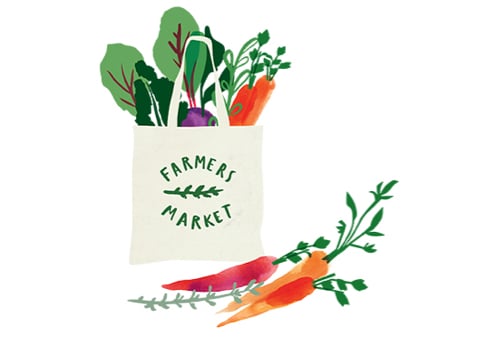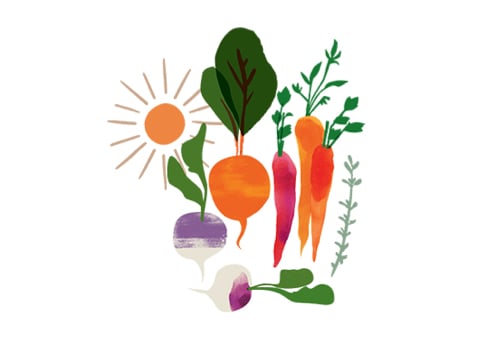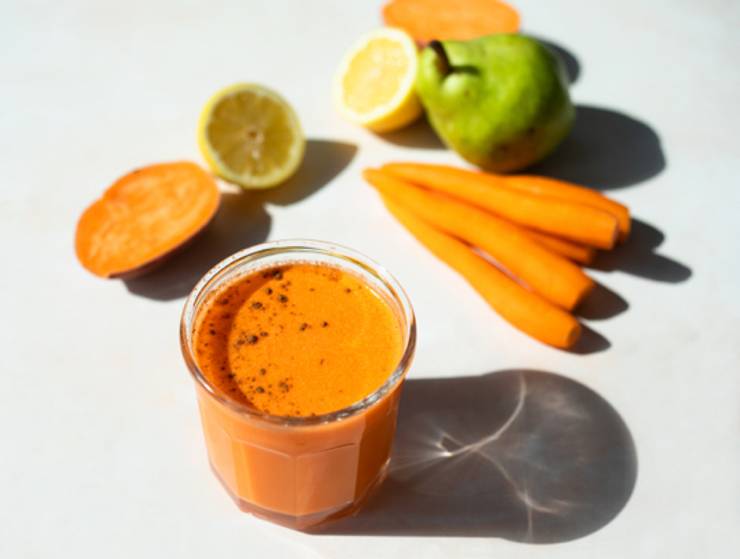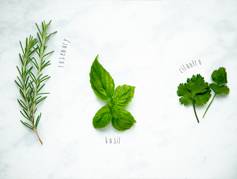Articles
Feel the Chill: A Seasonal Guide to the Fall Transition
Fall is a season full of transitions, as the air becomes crisp and the leaves turn colors. Kids are back in school, while adults get busier with work and start to prepare for the holiday season.
It’s also an abundant time to enjoy fruits and vegetables packed with nutrients that can help your body transition from summer into winter.
“Autumn is the season of gathering nature’s products before winter’s rest,” writes Dr. Elson Haas in his seminal book, Staying Healthy With The Seasons.
It’s true that this season is known for the harvest, as it’s the time to gather ripe crops from the fields. Farmers’ markets and grocery stores are bursting with the best this season has to offer— from sweet potatoes and pumpkins to Brussels sprouts, apples and cranberries—you’ll be thrilled at what flavors you can add to your juice and meal rotation.
Let’s discuss why fall is the best season to enjoy more root vegetables, in particular, and how those vegetables can help you feel more grounded. And yes, you can juice many root vegetables, and other fall favorites like sugar pumpkins.

Fall Rituals
With shorter days and cooler temperatures, you may notice a natural drop in energy.
The autumn equinox on September 22 marks the shift into this new season. The word “equinox” is derived from two Latin words aequus, meaning “equal,” and nox, which means “night.” This event occurs when the planet’s tilt becomes perpendicular to the sun, causing the days and nights to become equal. As the season continues, the days become shorter than the nights.
In Ayurveda, an ancient holistic healing system from India still practiced today, autumn is considered vata season, characterized by dry, cold and windy weather. Foods like pumpkin bread or hearty soups made of root vegetables help to ground us and subdue the dry, erratic nature of this transitional season.
In Kate O’Donnell’s book, The Everyday Ayurveda Cookbook, she writes, “This is an important time to prepare the body for the cold months by clearing out accumulated summer heat and storing nourishment in the deep tissue layers to sustain energy throughout the winter. Cooking with the early fall harvest of bitter and astringent foods such as cranberries, dark leafy greens, and pumpkins helps the body expel leftover heat.”
She recommends favoring root vegetables this season such as sweet potatoes, carrots, turnips, parsnips and winter squashes, along with taking care to relax, get enough rest and nap if needed.
Feeling Rooted
What does it mean for you to get rooted or stay grounded during this season? For many, it might look like keeping calm or feeling connected to who you are. With so much going on in our lives, it’s easy to get swept up in our schedules and forget about taking time for self-care.
Fall can be a wonderful time to connect with your personal mission or values. How can you stay present in this season of transition? What new challenges are coming your way and what practices can you begin or maintain to meet them?
Maybe this month is a great time to start journaling in the morning, try a new mindfulness practice or get more connected to nature by enjoying the fall breeze or positioning your desk closer to a window so you can view the outside more often. Of course, you can also take some time in the kitchen to enjoy seasonal foods and try new juice recipes like this Cranberry Citrus Juice.
Wellness activist and New York Times bestselling author Kris Carr has said, “When you’re the conscious captain in your kitchen, you’ll feel better mentally and physically.”

Immune Support
Fall marks the beginning of cold and flu season and for the past few years, worries about the global health pandemic. Thankfully, many seasonal fall foods offer nutrients specifically designed to help keep our immune systems strong.
In an interview with Meryl Fury, MS, RN, a registered nurse who works with underserved populations and whose personal mission is to make healthy habits accessible to everyone, she stressed the importance of taking care of ourselves throughout the year, not just when we need it.
“It's the equivalent of having an arm wrestling match coming up in a week, so today you start doing curls, right?” she said. “It would make a difference if you had been doing curls for the last two years. Our immune systems are like that too.”
Fury recommends keeping your diet full of high quality, nutrient dense foods all the time.
“Then, when these viruses and other bacteria and microbes come along, you are already fairly well protected,” she said.
She recommends exercise as another way to keep your immune system strong and specifically, walking outside with sun shining directly on your skin to help your body produce vitamin D, which is known for helping regulate the immune system.1

It’s easy as temperature drops to stay inside, but your immune system will thank you if you continue to move. Plus, walking has been shown to help boost creative inspiration, which can help you launch new creative projects.2
The season provides plenty of opportunities to enjoy outdoor activities such as raking leaves, going apple picking or playing flag football or frisbee golf. Just remember to dress appropriately with warmer clothing, especially in windy, colder weather.
When it comes to foods, root vegetables are a wonderful fall food. These vegetables absorb their nutrients from the soil, which helps fortify them with added vitamins and minerals.
Don’t forget the greens attached to many of these roots can be enjoyed too. For example, turnips are a great rounded root vegetable that come with a bonus—turnip greens. These leaves can be juiced or cooked like any other hardy green vegetable.

Another great seasonal immune booster is pumpkins, which are packed with vitamins, potassium and fiber.3 Plus, pumpkin seeds are a great source of plant-based protein and fat. You can roast them or add them to a nut milk.
Many people often wonder if all varieties of pumpkins are edible, and the short answer is yes. Of course, some varieties have been bred to have tastier flesh and less seeds, which make them easier to consume. If you want to add pumpkin to a juice or dessert, look for varieties like Cinderella, Orange Smoothie, Small Sugar or Spookie.4
On top of the seasonal favorites, it might be fun to try something new this fall. Lesser known root vegetables like parsnips, rutabagas and turnips offer great taste and nutritional benefits as well.
Consuming a wide variety of plant foods each week is one of those underappreciated ways to increase your health. Having greater diversity of plant types in your diet plays a role in the health of your gut microbiome, according to data collected from the American Gut Project.5
Researchers found that “no matter the diet they prescribed to (vegetarian, vegan, etc.), participants who ate more than 30 different plant types per week had gut microbiomes that were more diverse than those who ate 10 or fewer types of plants per week,” according to a statement.6
The gut microbiome helps many systems in the body stay in balance, including the digestive system and the immune system.7
COMMUNITY MEMBER SPOTLIGHT

Juicing Tips
from Tren Edwards
1. What is your favorite recipe to make in a large batch?
My favorite recipe to batch prep for juicing is cilantro, lime, apple, pineapple and ginger. It’s very simple, yet refreshing and sweet with a little kick.
2. What are your favorite fall juicing tips?
Always purchase in-season fruits and vegetables for a larger variety of the freshest, sweetest flavors with maximum nutritional benefits.
Sweet potatoes pair well with sweet pears, carrots, pineapple, ginger and a dash of cinnamon on top of the juice. The in-season produce creates a wholesome and delicious autumn juice, with immune-boosting properties.
Our Favorite Produce Available Right Now
Here’s our guide to some of the best seasonal fruits and veggies this season. Remember: seasonal foods will vary depending on where you live, soil conditions and weather.
BEST FRUITS
APPLES
Fall is a peak time for apples throughout much of the U.S. Despite their sweet taste, apples are a nutrient-dense fruit with a low glycemic index of about 36.8 FYI: The glycemic index measures how food impacts your blood sugar levels on a scale from 0 to 100. Foods that rank below 55 are considered low, meaning they tend to release glucose slowly at a steady pace. They are also a great source of potassium and beta carotene.9

• Shopping Tip: To find the freshest apples or new varieties that you’ve never tried before, make a trip to a local farm or farmers’ market. Always look for apples that are free of holes, bruises, and soft spots and feel firm to the touch.
• Varieties: More than 7,000 varieties exist and about 100 are grown commercially in the U.S. Look for red, pink, green and golden colors that can taste sweet or tart. Try sweet kinds such as Fuji, Golden Delicious, Honey Crisp or Gala. Tart varieties include Granny Smith, Braeburn or Sierra Beauty.
• Storage Tip: The best way to store apples is at room temperature for up to two weeks. They will also stay fresh in the refrigerator for a month or so. Avoid washing them until ready to eat. You can prevent apple slices from browning by lightly squeezing lemon juice on them to help prevent oxidation.
CRANBERRIES
Known as a holiday side dish, cranberries are an American superfood since they are native to the Northeastern U.S. and Canada. They uniquely grow in bogs (a freshwater wetland). During the fall, these bogs become flooded, making cranberries float, which makes them easy to harvest.10 These small red berries are a rich source of several bioactive flavonoids including flavanols, anthocyanins and proanthocyanidins.11

• Shopping Tip: When shopping for fresh cranberries, look for ones with glossy red skin that feel firm to the touch. They also bounce when they are ripe.
• Storage Tip: Keep fresh berries in the fridge for up to one month.
• Juicing Tip: They do taste quite tart (maybe even bitter to some palates), so they pair well with sweeter ingredients like apples, carrots, or oranges.
BEST VEGETABLES
SWEET POTATOES
These sweet starchy tubers are native to Central and South America, their look-alike counterparts yams are native to Asia and Africa. Confused about the difference between yams and sweet potatoes? The potatoes have tapered ends and smoother skin, while yams have rough exterior and are typically more cylindrical.
Whatever you want to call them, these veggies serve up lots of nutritional benefits. Sweet potatoes are low in calories and huge in vitamin A, along with fiber, vitamin C and potassium.12

• Shopping Tip: Size doesn’t matter when shopping for sweet potatoes, but if you want to cook them, you’ll want to try to buy even sizes so they cook at the same rate.
• Varieties: More than 6,500 varieties of sweet potatoes exist, according to the International Potato Center in Peru. Some of the more popular varieties you can find at the store include Jewel, Garnet, Purple and White.
• Storage Tip: These veggies don’t belong in the fridge. Instead, opt for a cool, dark place and they can stay fresh for about a month.
PUMPKINS
The great pumpkin (made popular by Peanuts comics) has become a staple in homes during this season. Yes, they are fun to decorate, but they are also great to eat— like adding them to your favorite vegetarian chili or juice. In fact, juicing pumpkin is a great way to get a healthy dose of vitamins and minerals. Pumpkins contain carotenoids, which are antioxidants that are linked to a lower risk of cancer.13

• Shopping Tip: Choose pumpkins without any holes or brown, smooshy spots.
• Storage Tip: Store in a cool, dry spot for up to six months, depending on the variety.
• Juicing Tip: Treat pumpkin like any other winter squash. You can leave the skin on, but remove the stem and seeds. It pairs great with apples, pears, lemons, and ginger.
KALE
This hardy cruciferous green can withstand cooler weather, even snowfall, making kale a great fall and winter vegetable. It’s no secret that kale is popular among juicers because it’s so full of amazing nutrients like fiber, calcium, potassium and even a small amount of protein.14

• Shopping Tip: Avoid kale that looks wilted or has yellow leaves and opt for strong, crisp and brightly colored green (or purple) leaves. Once home, wrap your kale in a paper towel and store in your crisper drawer for up to one week.
• Varieties: You can find many types of kale including Lacinato (also called Tuscan kale), Red Russian, Curly, Scarlet or Japanese flowering kale. Also look for baby kale.
• Prep Tip: You can juice kale with the leaves and stems, but if you’re making a salad you can easily remove kale from its stem with your hands. Simply hold the kale upside down and then from one end of the stem, begin to pull the leaves down.
FALL HIGHLIGHTS
5 INGREDIENTS TO JUICE RIGHT NOW
- Apple: a seasonal favorite that adds sweetness to any juice
- Cranberry: offers a powerful antioxidant punch with a tart taste
- Sweet Potato: yes, you can juice them and enjoy their creamy texture
- Pumpkin: combine with apple and spices for a true harvest treat
- Kale: brings all the green goodness to your drink
sources:
- https://www.sciencedaily.com/releases/2019/04/190417111440.htm
- https://news.stanford.edu/2014/04/24/walking-vs-sitting-042414
- https://fdc.nal.usda.gov/fdc-app.html#/food-details/168448/nutrients
- https://gardenerspath.com/plants/vegetables/best-pie-pumpkins
- https://microsetta.ucsd.edu
- https://health.ucsd.edu/news/releases/Pages/2018-05-15-big-data-from-worlds-largest-citizen-science-microbiome-project-serves-food-for-thought.aspx
- https://www.bmj.com/content/361/bmj.k2179
- https://www.health.harvard.edu/diseases-and-conditions/glycemic-index-and-glycemic-load-for-100-foods
- https://fdc.nal.usda.gov/fdc-app.html#/food-details/1102644/nutrients
- https://education.nationalgeographic.org/resource/bog
- https://www.ncbi.nlm.nih.gov/pmc/articles/PMC4033875
- https://fdc.nal.usda.gov/fdc-app.html#/food-details/168483/nutrients
- https://pubmed.ncbi.nlm.nih.gov/31487816
- https://fdc.nal.usda.gov/fdc-app.html#/food-details/1957413/nutrients
- Choosing a selection results in a full page refresh.
- Press the space key then arrow keys to make a selection.



